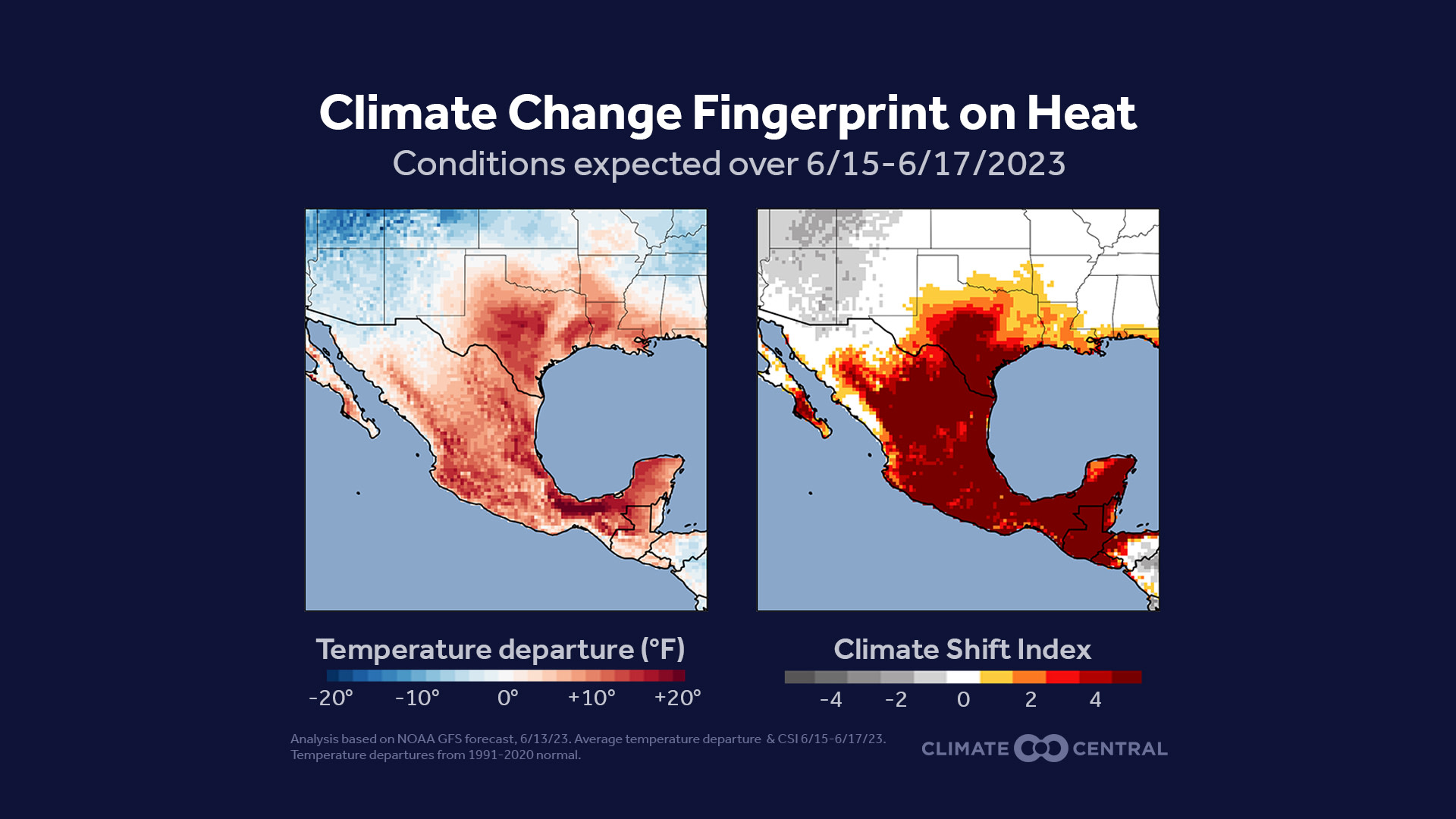Climate Central analysis shows that human-caused climate change is making the near-record heat forecast in large parts of Texas and Mexico at least 5 times more likely.
Forecasts indicate a week-long stretch of anomalous and extreme heat is expected across a large region from Central America to the southern United States. Near-record high temperatures over 105°F are forecast in major cities, from Thursday, June 15, through Monday, June 19, 2023.
Daily maximum temperatures during the height of this event (between June 15 and 17) are expected to reach Climate Shift Index (CSI) levels of 5 across the region, including Guatemala, northeastern, central and southern Mexico, large swaths of western, central, and southern Texas, and southwestern Louisiana. Level 5 indicates that human-caused climate change made this excessive heat at least 5 times more likely.
"Human caused climate change made the extreme and extremely unusual temperatures in Mexico and the southern US much more likely. Heat this intense, this early in the year will create stressful conditions for millions of people." - Dr. Andrew Pershing, vice president for science, Climate Central
Daytime temperatures are forecast to exceed 100°F in several cities in Texas. Daytime high temperature records in the region for June 17 include 106°F (Austin, in 2011), 104°F (San Antonio, in 2011), 100°F (Houston, in 2011), 110°F (Laredo, in 1998), 105°F (McAllen in 2017), and 109°F (San Angelo, in 2017).
This extreme heat may present health and safety risks, particularly in combination with elevated humidity levels that will contribute to heat index values near 110°F as well as the potential for increased exposure as people in the U.S. celebrate Father’s Day and Juneteenth.
Populations most vulnerable to high heat include older adults, young children, pregnant women, individuals with chronic conditions, members of low-income and historically marginalized communities, athletes, and outdoor workers.
Texas power utility ERCOT is forecasting demand near capacity levels on Friday, June 17. Residents should develop a preparedness plan in the event of a localized power failure.
For more information on heat and the related human health implications refer to our Climate Matters brief, More Risky Heat Days in 232 U.S. Locations, which found a significant increase in annual days above local risky heat thresholds in several Texas cities. Austin now experiences 53 more risky heat days per year than in 1970. McAllen and Houston now experience 52 and 51 more risky heat days, respectively, than in 1970.
Reporting resources as this heat event unfolds:
Exposure to risky heat can trigger heat-related illnesses, including heat exhaustion and heat stroke, a life-threatening condition. For more information on heat safety, visit the National Integrated Heat Health Information System’s Planning and Preparing guide.
The U.S. Climate Shift Index map tool has free maps showing the fingerprint of climate change on local average, maximum, and minimum temperatures.
The influence of climate change on daily average temperatures across the globe is available on the global Climate Shift Index map.
Explore quick facts and local analyses on the links between climate change and extreme heat in Climate Central’s Extreme Weather Toolkit: Extreme Heat, World Weather Attribution’s guide to reporting on extreme heat and climate change, and a summary of the connection between heatwaves and climate change from Yale Climate Connections.
About the Climate Shift Index ™
Climate Central’s Climate Shift Index ™, grounded in the latest peer-reviewed science, maps the influence of climate change on temperatures across the globe, every day.
Climate Shift Index ™ levels indicate how much human-caused climate change has altered the frequency of daily temperatures at a particular location. Level 1 indicates that climate change is detectable in that day’s temperature. Level 2 means that climate change made exceptionally warm temperatures in a given location at least twice as likely. Level 5 is the maximum and indicates temperatures at least 5 times more likely because of climate change.
For this analysis, temperatures come from NOAA’s Global Forecast System model.
